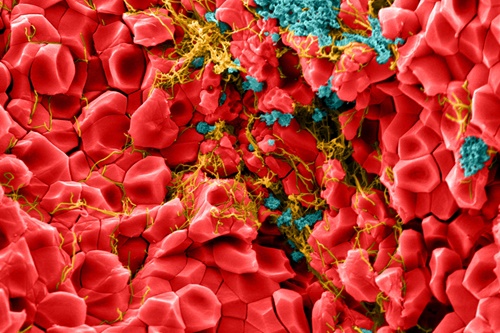5 November 2015. A biochemistry lab at University of British Columbia developed a technique for supercharging blood platelets with genetic material, enabling these cells to deliver therapies through the blood stream. The team led by biochemist and molecular biologist Christian Kastrup published its findings this week in the journal Angewandte Chemie International Edition (paid subscription required).
Kastrup and colleagues in Vancouver, Canada are seeking a way to expand the use of platelets as healing mechanisms. Platelets are cells in the blood whose function is to stop bleeding from broken blood vessels. The cells respond to signals of a damaged blood vessel from a protein known as thrombin and accumulate at the site forming a clot, which slows the blood flow. The clot forms by platelets depositing a natural polymer called fibrin at the point of damage, which changes the shape of the platelets and lets them clump together in a clot to staunch the blood flow.
The team considers platelets a promising vehicle for more functions because of their simple structure. These cells do not have a nucleus, thus they have no nucleic acids such as DNA carrying genetic codes that get transcribed into RNA with instructions for cells to produce proteins. The researchers are seeking a more efficient way of delivering these RNA instructions to cells with nuclei, known as eukaryotic cells, than some existing (and inefficient) gene therapy or synthetic biology methods.
The UBC team started with current work on protocells, round synthetic cell replicas with fatty acid membranes called liposomes and enzymes from RNA that promote RNA growth and replication. Protocell technology is being developed for therapies, but so far is not working directly with live eukaryotic cells.
To meet this objective, the researchers adapted the functions of protocells to platelets. They devised a technique for injecting RNA with nanoscale liposomes into platelets, then activating the RNA with light beams. In lab tests, their technique succeeded in delivering RNA to platelets, then activating and transcribing the RNA into proteins. The researchers say this is the first time the process was induced inside mammalian cells, rather than protocells.
“Platelets are a basic component of blood,” says Kastrup in a university statement, “so they make an excellent way to deliver therapies to people with uncontrollable internal bleeding, or inflammatory diseases, or dangerous clots.” But this capability, he adds, can also be extended to conditions other than blood disorders. “We’ve gotten platelets to make their own RNA,” notes Kastrup. “Our next step is getting them to make therapeutic RNA, or therapeutic proteins.”
Read more:
- Gene Editing Boosts Red Blood Cell Output in Lab
- Delivery Technique Devised to Cross Blood-Brain Barrier
- Trial Begins Testing Sickle Cell Blood Therapy
- Nanoneedles Deliver Therapeutic DNA, Grow Blood Vessels
- Synthetic Blood Thinner Antidote Developed
* * *


 RSS - Posts
RSS - Posts
You must be logged in to post a comment.